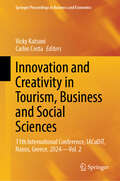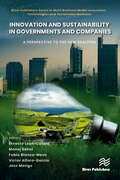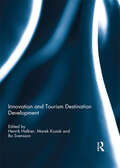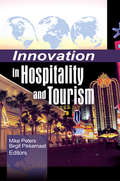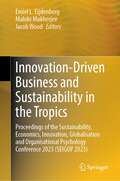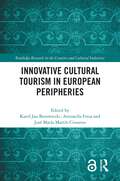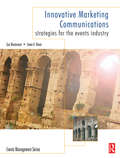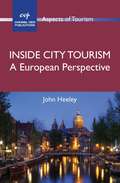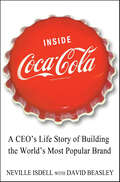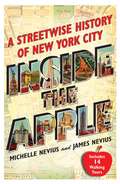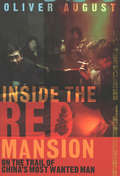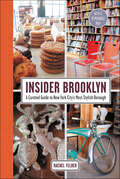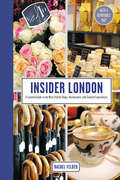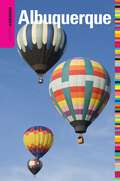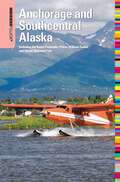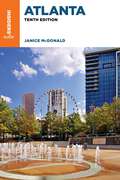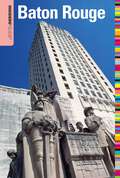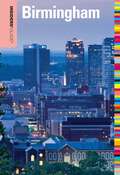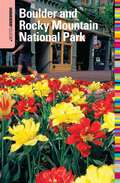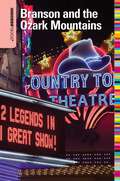- Table View
- List View
Innovation and Creativity in Tourism, Business and Social Sciences: 11th International Conference, IACuDiT, Naxos, Greece, 2024 - Vol. 2 (Springer Proceedings in Business and Economics)
by Carlos Costa Vicky KatsoniThis book is the second volume of the proceedings of the 11th International Conference of the International Association of Cultural and Digital Tourism (IACuDiT). Focusing on &“Innovation and Creativity in Tourism, Business and Social Sciences,&” the conference was held from September 3 to 5, 2024, in Naxos, Greece. The book showcases the latest research on tourism business, technology, and the social sciences and presents a critical academic discourse on ICT adoption in the social sciences, regional development; sustainability and tourism experience; smart and sustainable practices; innovations in museum interpretation and collections management; emerging and disruptive technologies; gaming, gamification and augmented reality, and other topical aspects in business and the social sciences. The book discusses these digital transformation processes from various standpoints, including its effect on the social sciences combined with specific forms of tourism. The impact of digitalization encourages the emergence of new digital products and services based on the principle of flexibility. The book focuses on the knowledge economy and the &“smart destinations&” concepts and highlights new modes of tourism management and development, while further chapters address emerging technologies, such as the Internet of Things, AI, big data, and robotics in a range of tourism practices.
Innovation and Sustainability in Governments and Companies: A Perspective to the New Realities (River Publishers Series in Multi Business Model Innovation, Technologies and Sustainable Business)
by Fabio Blanco-Mesa Manoj Sahni Ernesto Leon-Castro Victor Alfaro-Garcia Jose MerigoInnovation and sustainability are issues that have become very relevant in recent years. This book presents a compilation of investigations on these topics, divided into those applied in government or enterprises. The objective is to demonstrate to the audience how these issues have been worked around the world and in different scenarios. Among the papers, there are works related to economic variables, imports, exports, and analysis in different sectors such as tourism, agriculture, education, and even in countries in general.
Innovation and Tourism Destination Development
by Henrik Halkier, Marek Kozak and Bo SvenssonTourism is a central part of regional development strategies in many localities around Europe, not just in traditional coastal or mountain resorts but also in areas without a strong track record with regard to visitor economy. In a globalising world, destinations can no longer take their traditional visitors for granted and escape growing competitive pressures, because increasingly experienced, specialised and demanding travellers now have a vastly greater number of potential destinations to choose from. Both well-established and emerging tourist destinations are therefore under pressure to be innovative to increase their attractiveness in the globalising visitor economy. This book focuses on the role played by tourist destinations – conceived as multi-layered and functional governance structures – in stimulating or complicating the development of new tourist experiences. The complex relationship between firm-level and territorial development dynamics is, of course, by no means confined to tourism development, and the book will therefore be of a more general relevance for research into innovation and spatial development dynamics.This book was published as a special issue of European Planning Studies.
Innovation in Hospitality and Tourism
by Mike PetersGet the latest research on new ways to measure innovation in the tourism value chainUntil now, most available research on innovation in tourism product service and development has focused on concepts, rather than facts. Innovation in Hospitality and Tourism presents empirical studies that identify the major "push and pull" factors of innovation in hospitality and tourism, providing vital information on how to measure innovation in the control and sustainable management of new service development. This unique book examines the internal and external drivers of innovation in the market place, the difference between innovative firms and those that merely follow trends, and explanations and examples of innovations in special areas of the tourism value chain.With hospitality markets saturated and clients selecting services from all over the world, it&’s not enough to have an innovative idea for a new tourism product-your idea has to have the potential to be successfully marketed. Innovation in Hospitality and Tourism looks at methods of measuring the market-based applications of new processes, products, and forms of organization, the economic impact of innovation, innovation as a bipolar process between market and resources, and forms of cooperation that can strengthen and reinforce innovation. The book&’s contributors analyze the relationship between welfare services and tourism in Denmark, the innovation potential throughout the tourism value chain from the supply side focus, innovation as a competitive advantage in Alpine tourism and in the small- and medium-sized hotel industry, tourism innovation statistics across products, providers, markets, and geopolitical regions, and a case study of AltiraSPA, a wellness concept of the ArabellaSheraton group.Innovation in Hospitality and Tourism examines: product development measuring innovation consumer-based measurement of innovation innovation processes in hotel chains innovation performances in hotel chains and independent hotels mobile business solutions for tourist destinations Internet portals in tourism analyzing innovation potential leadership and innovation processes welfare services and tourism as a driving force for innovation SERVQUAL as a tool for developing innovations and much moreInnovation in Hospitality and Tourism is an invaluable resource for academics, professionals, practitioners, and researchers working in the field of hospitality and tourism.
Innovation-Driven Business and Sustainability in the Tropics: Proceedings of the Sustainability, Economics, Innovation, Globalisation and Organisational Psychology Conference 2023 (SEIGOP 2023)
by Emiel L. Eijdenberg Malobi Mukherjee Jacob WoodThe edited volume presents the conference proceedings from the “Sustainability, Economics, Innovation, Globalisation and Operational Psychology Conference 2023” (SEIGOP 2023), organized by the Centre for International Trade and Business in Asia (CITBA) at James Cook University, Singapore. This edited volume places the highly dynamic, but also, jeopardized climatological – geographical region of the Tropics centre stage. The region is developing rapidly, with significant progress being made through the development of innovative technologies. The Tropics represent a region in which people live amid the greatest level of biodiversity anywhere on the planet. Nonetheless, propelled by rapid population growth, the Tropics is a region on the rise, with higher living standards and increased levels of international trade and investment. Densely populated emerging countries like India, Indonesia and Nigeria will be among the largest economies of the world by the end of the century. These upward socioeconomic trends are compromised by the impact of climate change on the Tropics’ biodiversity. Such developments have forced policymakers, businesses, and local communities to search for more sustainable and creative ways to live and work. For these reasons, this edited volume presents theory-driven conceptual, qualitative, quantitative and mixed-methods studies on the impact of innovation-driven businesses on the complex interplay of socio-cultural, economic, and environmental factors in the Tropics.
Innovationsmanagement in der Spitzengastronomie: Ein Überblick über die Sterneküche aus managementorientierter Perspektive (essentials)
by Andreas Braun Gordon Müller-SeitzDas essential beschreibt aus einer managementorientierten Perspektive das Innovationsgeschehen in der Sternegastronomie und erkl#65533;rt die zugrundeliegenden Prozesse, den organisationalen Aufbau sowie die #65533;bergeordneten Strategien. Auf Basis einer Studie und zahlreicher Interviews mit Sternek#65533;chen geben die Autoren einen fundierten Einblick in die moderne Spitzengastronomie, die sich durch einen hohen Grad an Kreativit#65533;t und Innovation auszeichnet und in dessen Zentrum der einzelne Sternekoch als Ideengeber und Prozesstreiber steht. Die Entwicklungs- und Umsetzungsprozesse in der Sternek#65533;che k#65533;nnen in einem Cross-Industry-Ansatz neue Ideen auch f#65533;r das Innovationsmanagement anderer Branchen liefern.
Innovative Cultural Tourism in European Peripheries (Routledge Research in the Creative and Cultural Industries)
by Karol Jan Borowiecki Antonella Fresa Civantos, José María MartínCultural tourism can play an important role in social and territorial cohesion. Focusing on European peripheral regions, this book illuminates the importance of local communities in heritage management for sustainable development.This book provides insights into the use of innovative business models and tools, such as ecosystem services contracts and digital narrative platforms, to enhance the sustainability and economic development of peripheral and marginal destinations. Additionally, this book addresses the value of data collection and analysis in cultural tourism and provides insights into participatory models and approaches that contribute to sustainable tourism development.With contributions from a pan‑European range of expert scholars and practitioners, this book serves as an essential resource for researchers, professionals, and anyone with an interest in tourism, and the cultural and creative industries.The Open Access version of thi book, available at www.taylorfrancis.com, has been made available under a Creative Commons Attribution-Non Commercial- No Derivatives (CC-BY-NC-ND) 4.0 license.
Innovative Marketing Communications: Strategies For The Events Industry (Events Management)
by Emma Wood Guy MastermanInnovative Marketing Communications for Events Management provides students and event managers with a complete insight into the strategic and innovative marketing of events of all scales and nature. The book builds a conceptual framework for the development, planning, implementation and evaluation of innovative communication strategies for the marketing of events, and the effective use of events as an innovative communications method in general organizational marketing.With a strong practical underpinning, Innovative Marketing Communications for Events Management emphasises to event managers the importance of effectively integrating a range of tools and techniques to communicate the event and provides them with a better understanding of how a variety of private and public sector organisations can use events within their communication strategies.
Inside City Tourism
by John HeeleyCities are the dominant geographical focus of business and leisure tourism travel, and cities everywhere are regenerating and reinventing themselves so as to attract visitors, students and investment. Inside City Tourism explores the organisational challenges to which this gives rise, and in particular examines the history, structure and functioning of the urban delivery mechanisms set up to raise profile and maximise tourism. The book is written by the Chief Executive Officer of European Cities Marketing who - as a former tourism academic and city marketing professional - is uniquely placed to synthesise academic and practical insights and to provide a distinctively European overview. While cities increasingly seek to differentiate themselves through brands, events and iconic structures, the approaches, techniques and language used by cities to promote themselves is remarkably similar across the length and breadth of Europe. Never before published case material exemplifies best practice in city marketing, with the greater part of leading edge practice to be found in Scandinavia, Holland, Germany, Austria and Spain. Inside City Tourism 'tells it like it is', uncovering the pitfalls and failures as well as the opportunities and successes, and the attendant leadership challenges. It is essential reading for practitioners and policymakers as well as students and academics.
Inside Coca-Cola: A CEO's Secrets on Building the World's Most Popular Brand
by David Beasley Neville IsdellThe first book by a Coca-Cola CEO tells the remarkable story of the company's revivalNeville Isdell was a key player at Coca-Cola for more than 30 years, retiring in 2009 as CEO after regilding the tarnished brand image of the world's leading soft-drink company. This first book by a Coca-Cola CEO tells an extraordinary personal and professional world-wide story, ranging from Northern Ireland to South Africa to Australia, the Philippines, Russia, Germany, India, South Africa and Turkey. Isdell helped put out huge public relations fires (India and Turkey), opened markets(Russia, Eastern Europe, Philippines and Africa), championed Muhtar Kent, the current Turkish-American CEO, all while living the ideal of corporate responsibility. Isdell's, and Coke's, story is newsy without being gossipy; principled without being preachy. Inside Coca-Cola is filled with stories and lessons appealing to anybody who has ever taken "the pause that refreshes." It's also a readable and important look at how companies can market and govern themselves more-ethically and to great success.
Inside Out: Off the Map 3 (Off the Map #3)
by Lia RileyLove is uncharted territory - sometimes in order to find yourself, you need to venture off the map . . . Lia Riley made New Adult readers fall in love with her breakout debut, Upside Down. Sideswiped, the second of her series, made readers clamour for more. Now, with Inside Out, Lia Riley brings her evocative Off the Map series to a stunning conclusion.When Talia first moved from California to Australia to study abroad, she never dreamed she'd find the love of her life. Bran understands her like no one ever has before. And despite the numerous challenges they've faced, they've always managed to figure out how to stay together. But this time they'll face their toughest hurdle yet. Is their love strong enough to keep them together?Book #3 in the OFF THE MAP seriesPraise for Lia Riley:'Upside Down gave me all the feels. Romantic and poignant, the journey of love and acceptance lingers long after the book is closed' Jennifer L. Armentrout/J. Lynn, #1 New York Times bestselling author'Must read romance . . . refreshing and heartfelt New Adult contemporary romance' USA Today'Addictively readable' Booklist (starred review)'Riley writes a captivating story from beginning to breathtaking end' Publishers Weekly starred review'Fresh, sexy, and romantic. I cannot wait for the next book' Kristen Callihan, bestselling author'Fast paced, electric and sweetly emotional!' Tracy Wolff, New York Times bestselling author'Where to even start with this book? Beautifully written, Australia, hot surfer Bran, unique heroine Talia. Yep, it's all just a whole lot of awesome. Loved it!' Cindi Madsen, USA Today bestselling author'A rich setting and utterly romantic . . . I absolutely loved it!' Melissa West, author of Pieces of Olivia'Upside Down is a brilliantly-written New Adult romance that transported me to another country. With vivid imagery and rich characterisations, I was completely smitten with the love story of Bran and Talia. I cannot wait for the rest of their story!' Megan Erickson, author of Make it Count'If you're looking for funny, well-written new adult romance - Lia Riley is an author to try' She Reads New Adult
Inside the Apple: A Streetwise History of New York City
by Michelle Nevius James NeviusHow much do you actually know about New York City? Did you know they tried to anchor Zeppelins at the top of the Empire State Building? Or that the high-rent district of Park Avenue was once so dangerous it was called "Death Avenue"? Lively and comprehensive, Inside the Apple brings to life New York's fascinating past.This narrative history of New York City is the first to offer practical walking tour know-how. Fast-paced but thorough, its bite-size chapters each focus on an event, person, or place of historical significance. Rich in anecdotes and illustrations, it whisks readers from colonial New Amsterdam through Manhattan's past, right up to post-9/11 New York.
Inside the Red Mansion: On the Trail of China's Most Wanted Man
by Oliver AugustA journalist meets fascinating characters while seeking out a fugitive gangster in the Chinese underworld.The notorious gangster Lai Changxing started out as an illiterate farmer, but in the tumult of China’s burgeoning economy, he seized the opportunity to remake himself as a bandit king. A newly minted billionaire of outsized personality and even greater appetites, he was a living legend who eventually ran afoul of authorities. The journalist Oliver August set out to find the fugitive Lai. On his quest he encountered a highly entertaining series of criminals and oddball entrepreneurs—and acquired unique insight into the paradoxes of modern China. Part crime caper, part travelogue, part trenchant cultural analysis, August’s page-turning account captures China’s giddy vibe and its darker vulnerabilities.Praise for Inside the Red Mansion“A year before “Inside the Red Mansion” was due to be published, a handler from the Chinese Foreign Ministry told August that he had enjoyed the book. You needn’t be a spy to agree.” —Janet Maslin, New York Times“A harrowing, super-detailed story of a China exploding with runaway growth yet still trapped in the past and ruled by the ethos of tufei—the classical Mandarin word for bandit . . . . This must-read, can’t-put-it down tale shows the China only hinted at on the evening news—a place of outsized egos, over-the-top commercial development and shadowy, tradition-bound authoritarian rule.” —Publishers Weekly
Insider Brooklyn: A Curated Guide to New York City's Most Stylish Borough
by Rachel FelderA trend and shopping expert and fourth-generation New Yorker’s chic, full-color guide to the best boutiques, shopping routes, restaurants, cafes, and bars in New York City’s “It” borough, highlighting more than 200 favorite destinations and shops for both style-oriented travelers and New Yorkers alike.The fourth most popular travel destination in the world, New York City draws millions of visitors annually, including more than fifty-four million people in 2014 alone. At the center of this white-hot destination is none other than the borough of Brooklyn—the mecca of twenty-first century cool and style. Now, native New Yorker Rachel Felder, a widely published journalist specializing in fashion, beauty, travel, and trends, has created a portable, beautifully designed, personally curated anthology that brings this fashionable borough into focus as never before, featuring not-to-be-missed highlights and covering everything—from food to furniture to fashion—it has to offer.Rachel takes you into some of the borough’s most diverse and charming neighborhoods, including Brooklyn Heights, Park Slope, Williamsburg, Fort Greene, Boerum Hill, Carroll Gardens, Prospect Heights, and DUMBO. She begins with valuable travel advice, including a precisely selected list of hotels, cafes, bars, bakeries, festivals, salons, and markets. She provides a sample itinerary for trip planning, as well as a comprehensive list of Brooklyn’s main attractions—including its major landmarks, parks and gardens, museums and zoos, noteworthy restaurants, bars and breweries, and artisanal food shops. She then takes you into individual neighborhoods, exploring each thoroughly by shop type and goods, providing the complete address, phone number, and website for each.Insider Brooklyn is filled with must-have advice on trendsetting furniture and décor; antiques and vintage; clothing for men, women, and children; jewelry, both affordable and high-end; beauty—makeup, perfume, and salons; health and wellness, including juices, gear, and fitness specialists; children’s goods; stylish kitchen essentials and decorating for the table; unique art and objects; rare oddities and curiosities; and favorite bookstores, specialty grocers, and niche shops. The stores have been chosen with an expert’s eye, including new discoveries, popular mainstays, and neighborhood gems worth visiting.Bursting with invaluable insights, helpful tips, and must-see destinations, Insider Brooklyn is an indispensable resource and a visual feast for tourists and business visitors headed to the city, locals—both Brooklynites and other New Yorkers—and armchair travelers who simply want to dream about and shop it from home.
Insider London: A Curated Guide to the Most Stylish Shops, Restaurants, and Cultural Experiences
by Rachel FelderSophisticated shopping and travel expert Rachel Felder, the author of Insider Brooklyn, takes you deep into the heart of the world’s most visited city—London—with her painstakingly curated selection of 200 not-to-be-missed destinations—major retailers, specialty boutiques, hotels, cultural venues, restaurants, cafes, and bars—hundreds of colorful photographs, a specially commissioned illustrated map, and an index of listings.In the past decade, London has consistently been the world’s top destination among international travelers, including nearly nineteen million visitors in 2015 alone. In this beautifully designed, practical, and portable compendium, Rachel, a widely published journalist specializing in fashion, beauty, travel, and trends, takes you on a unique, personalized tour of the city that is her second home. Insider London is, in essence, Rachel’s very own little black book, an annotated guide to the best of the city: heritage businesses and upstart boutiques, established and burgeoning neighborhoods, from Mayfair to trendy Shoreditch, and filled with essential information only a savvy Londoner would know. The coverage includes:City Essentials’ Hotels, Museums and Galleries, Parks and Open Spaces, Live Music Venues, and TheatersShops—Department Stores, Clothing and Fashion AccessoriesBeauty, Grooming, and WellnessDécor, Flowers, and Items for the HomeStationery, Books and GiftsMarketsFood and Drink—Restaurants; Pubs, Gastropubs, and Cocktail Bars; Quick Bites, Bakeries and Takeaways; Fish and Chips; Afternoon Tea; Coffee Bars and Tea HousesListings IndexEvery entry—from appointment-only boutiques to unique galleries to unusual tea purveyors—have been chosen with Felder’s refined tastemaker’s eye, including new discoveries, blink-and-you’ll-miss-it neighborhood gems, and quintessential mainstays. Rachel describes each venue in detail, highlighting its specialties and profiling the experience, and provides its complete street address, phone number, website, and closest tube station. An indispensable guide for London dwellers and visitors, Insider London is also visual feast for Anglophiles who simply want to dream about it and shop it from home.
Insiders' Guide® to Albuquerque (Insiders' Guide Series)
by Tania CasselleInsiders' Guide to Albuquerque is the essential source for in-depth travel and relocation information to one of New Mexico's most colorful cities. Written by a local (and true insider), this guide offers a personal and practical perspective of Albuquerque and its surrounding environs.
Insiders' Guide® to Anchorage and Southcentral Alaska: Including the Kenai Peninsula, Prince William Sound, and Denali National Park (Insiders' Guide Series)
by Deb VanasseFrom breathtaking mountains to untamed coastlines, Insider's Guide to Anchorage and Southcentral Alaska features Prince William Sound, the Kenai Peninsula, Anchorage, and Denali National Park.
Insiders' Guide® to Atlanta
by Janice McDonaldFrom the Martin Luther King National Site to the World of Coca-Cola, the High Museum of Art, and Stone Mountain Park, discover all that Atlanta has to offer. Written by local expert, Janice McDonald, Insiders&’ Guide® to Atlanta is the essential source on the big peach. Written for locals and travelers alike, this comprehensive guide covers in-depth travel information and tips, relocation advice, and much more. The newly researched, revised, and up-to-date edition features: Comprehensive listings of notable cuisine, memorable tourist attractions, unique experiences, lively nightlife, and quality accommodations Recommendations for shopping, entertainment, and children&’s activitiesAdvice on how to live and thrive in the area—from recreation to relocationSuggested itineraries for day trips, annual events, and exploring local secrets Our insider, Janice McDonald, owns her own Atlanta-based production company, J-Mac Productions, and has produced material for the Travel Channel, ABC, NBC, CBS, and VH-1, among others. She is a contributing editor for travel girl magazine and writes for numerous publications.Discover your travel destination. Your home. Your home-to-be.
Insiders' Guide® to Atlanta (Insiders' Guide Series)
by Janice McDonaldInsiders' Guide to Atlanta is the essential source for in-depth travel and relocation information to the Georgia's largest city. Written by a local (and true insider), this guide offers a personal and practical perspective of Atlanta and its surrounding environs.
Insiders' Guide® to Austin (Insiders' Guide Series)
by Hilary Hylton Cam RossieInsiders' Guide to Austin is the essential source for in-depth travel and relocation information to Texas&’s state capital. Written by locals (and true insiders), Insiders' Guide to Austin offers a personal and practical perspective of Austin and its surrounding environs.
Insiders' Guide® to Baltimore (Insiders' Guide Series)
by Judy ColbertInsiders' Guide to Baltimore is the essential source for in-depth travel and relocation information to the Maryland's largest city. Written by a local (and true insider), this guide offers a personal and practical perspective of Baltimore and its surrounding environs.
Insiders' Guide® to Baton Rouge (Insiders' Guide Series)
by Cynthia CampbellA first edition, Insiders' Guide to Baton Rouge is the essential source for in-depth travel and relocation information to the Louisiana's capital city. Written by a local (and true insider), this guide offers a personal and practical perspective of Baton Rouge and its surrounding environs.
Insiders' Guide® to Birmingham (Insiders' Guide Series)
by Todd KeithYour Travel Destination. Your Home. Your Home-To-Be.BirminghamFestivals. Architectural gems. Green spaces. Friendly faces. The Magic City. A special kind of place. • A personal, practical perspective for travelers and residents alike• Comprehensive listings of attractions, restaurants, and accommodations• How to live & thrive in the area—from recreation to relocation• Countless details on shopping, arts & entertainment, and children&’s activities
Insiders' Guide® to Boulder and Rocky Mountain National Park (Insiders' Guide Series)
by Ann LeggettA local authors uncovers the real Boulder, from the high mountains and sparkling streams of Rocky Mountain National Park to the historic buildings, shops, galleries, and more.
Insiders' Guide® to Branson and the Ozark Mountains (Insiders' Guide Series)
by Fred PfisterWritten by a local author, this guide is filled to the brim with insider information on everything from the top fishing sites to seasonal festivals and the best places to eat, sleep, and play.
